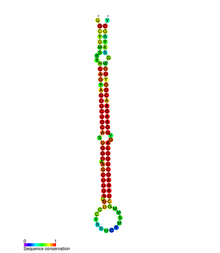Mir-22
| mir-22 | |
|---|---|

miR-22 microRNA secondary structure and sequence conservation
|
|
| Identifiers | |
| Symbol | mir-22 |
| Rfam | RF00653 |
| miRBase family | MIPF0000053 |
| Entrez | 407004 |
| HUGO | 31599 |
| OMIM | 612077 |
| Other data | |
| RNA type | microRNA |
| Domain(s) | Eukaryota; Euteleostomi |
| SO | {{{SO}}} |
In molecular biology mir-22 microRNA is a short RNA molecule. MicroRNAs are an abundant class of molecules, approximately 22 nucleotides in length, which can post-transcriptionally regulate gene expression by binding to the 3' UTR of mRNAs expressed in a cell.
Mir-22 was originally identified in HeLa cells (an immortal cell line derived from cervical cancer cells), but was later found to be ubiquitously expressed in various tissues. The gene encoding miR-22 is found on the short arm of chromosome 17, in a minimal loss of heterozygosity region. It is highly conserved across many vertebrate species, including chimp, mouse, rat, dog and horse. This level of conservation suggests functional importance. MiR-22 was previously identified as having a role in erythrocyte maturation.
The deregulation of many miRNAs has been shown to have a role in oncogenesis. Mir-22 was found to be over-expressed in prostate cancer but down-regulated in breast cancer, cholangiocarcinoma, multiple myeloma and . Mir-22 expression was associated with survival in multiple breast cancer datasets.
Specifically, miR-22 can function as a tumour suppressor. One known target is histone deacetylase 4 (HDAC4), which is known to have a critical role in cancer development. Mir-22 also targets Myc Binding Protein (MYCBP). This prevents transcription of c-Myc target genes by silencing c-MYCBP. However, c-Myc also inhibits expression of miR-22 in a positive feedback loop. When this spirals out of control, it can cause uncontrolled cell proliferation.
Expression of miR-22 can be induced by adding 12-O-Tetradecanoylphorbol-13-acetate (TPA) to HL-60 cells (leukaemia cell line). The enforced expression causes the growth of cancer cells to slow down. This means that miR-22 could be a potential target for cancer therapies.
...
Wikipedia
